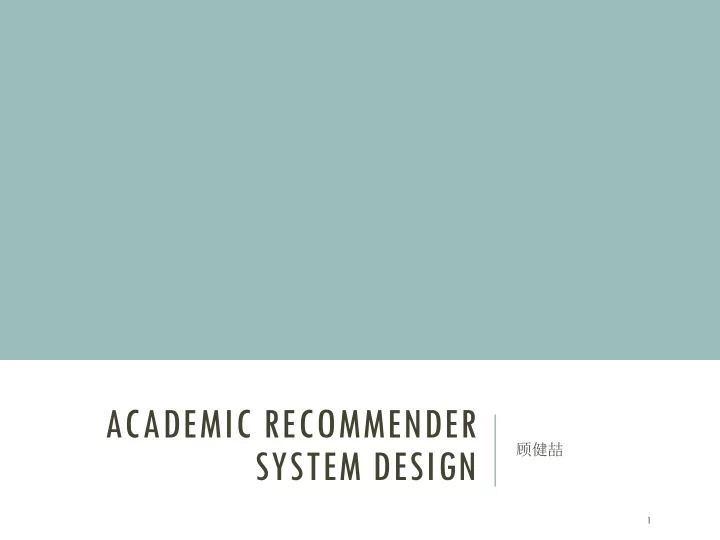

ACADEMIC RECOMMENDER 顾健喆 SYSTEM DESIGN 1
WHAT’S ACADEMIC RECOMMENDER SYSTEM Similar paper to paper Relevant paper to author Reading suggestion to user Recommendation is based on feature of paper. Title, Abstract, Keyword, Reference ,User’s activities… 2
INTRODUCTION OF RECOMMENDER SYSTEM Two Roles: User : Providing opinion to items e.g. Rating, Thumb up, Thumbing, Star… Item : Providing necessary information. Three Types: Content-Based Algorithm (CB) Collaborative Filtering Algorithm (CF) Hybrid Approach 3
CONTENT-BASED SYSTEM Providing recommendations by comparing the representations of content contained in an item to representations of content that interests the user. Extract item’s features 4
COLLABORATIVE FILTERING Finding a subset of users who have similar tastes and preferences to the target user and use this subset for offering recommendations. Preferences are recorded in the rating matrix . Two Main Approach: User-based Item-based 5
IDEA OF COLLABORATIVE FILTERING 6
USER-BASED COLLABORATIVE FILTERING Use user-item rating matrix Make user-to-user correlations Find highly correlated users Recommend items preferred by those users Pearson Correlation : Prediction Function : 7
USER-BASED COLLABORATIVE FILTERING Item I1 I2 I3 I4 I5 User U1 5 8 7 8 U2 10 1 U3 2 2 10 9 9 U4 2 9 9 10 U5 1 5 1 User a 2 9 10 Recommend items preferred by highly correlated user U3 Recommend I5 to User a. 8
ITEM BASED COLLABORATIVE FILTERING Use user-item ratings matrix ● Make item-to-item correlations ● Find items that are highly correlated ● Recommend items with highest correlation ● S imilarity Metric : Prediction Function : 9
ITEM BASED COLLABORATIVE FILTERING Item I1 I2 I3 I4 I5 User U1 5 8 7 8 U2 10 1 U3 2 10 9 9 U4 2 9 9 10 U5 1 5 1 User a 2 9 10 I5 is highly correlated to preferred items I4 10
HYBRID RECOMMEND APPROACH The problem of the Collaborative Filtering: Sparsity: Most users do not rate most items and hence the user-item rating matrix is typically very sparse. Cold Start: An item cannot be recommended unless a user has rated it before. Hybrid Recommend Approach can overcome these shortages. 11
CONTENT-BOOSTED COLLABORATIVE FILTERING Adding Content-based Predictor before Collaborative Filtering pseudo user-ratings vector : 12
ACADEMIC RECSYS DATA Content-based Recommender system Title Abstract Keyword Collaborative Filtering Recommender System Reference 13
HYBRID ACADEMIC RECSYS DESIGN 14
ACADEMIC COLLABORATIVE FILTERING RECSYS Integrating CF into the domain of research papers CF works with ratings matrix Columns represent ‘users’. Rows represent ‘item’ Maping citation web onto ratings matrix. Item 1 Item 2 User 1 R1,1 R1,2 User 2 R2,1 R2,2 15
MAPPING CITATION WEB ONTO CF RATINGS MATRIX(1) ‘Item’: Citations ‘User’: Real Users ‘Rating’: Users’ activities: Thumb Up, Thumb down, Rating etc. Problem: Startup problem Not enough users and users activities in the dataset 16
MAPPING CITATION WEB ONTO CF RATINGS MATRIX(2) ‘Item’: Citations ‘User’: Paper authors ‘Rating ’:”Vote” for the papers if he has cited Advantage: No startup problems Disadvantage: Many authors have written papers in several different fields over their careers. Serendipity is not useful in academic recsys. 17
MAPPING CITATION WEB ONTO CF RATINGS MATRIX(3) ‘Item’: Citations ‘User’: Paper ‘Rating’: Each paper would then vote for the citations found in its references list. Ciation1 Citation2 Citation3 Citation4 Citation5 Paper1 Paper2 Paper3 18
COLLABORATIVE FILTERING ALGORITHMS Co-Citation Matching Co-citation Matching works by counting co-citations User-Item CF User-Item algorithm compares papers (rows) in the matrix to create a neighborhood of the most similar papers to the target paper. Item-Item CF The Item-Item algorithm compares citations (columns) in the ratings matrix to create a neighborhood 19
ACADEMIC CONTENT-BOOSTED RECSYS Data Sparsity Ciation1 Citation2 Citation3 …………… Citation n Citation n+1 Paper1 1 Empty 1 Empty 1 1 Paper2 Empty 1 Empty Empty Empty Empty Paper3 1 Empty 1 Empty 1 Empty Serendipity is not useful The Long Tail 20
FIELD FILTER Serendipity is not useful Recommending paper in its filed. Using keyword and keyword hierarchy to extract paper’s field. Using PaperRank to find the important paper in fields. 21
TOPIC MODEL-BASED CONTENT-BASED PREDICTOR Using Topic Model to analyze the similarity of papers. Content: Title and Abstract ‘Title’ has more weight than ‘abstract’ Giving the top similar paper rating in the “Citation Matrix” Ciation1 Citation2 Citation3 Citation4 Citation5 Paper1 5 3 5 5 Paper2 5 3 5 Paper3 5 5 5 5 22
TEXT-CNN-BASED CONTENT-BASED PREDICTOR Feature A Abstract A Similarity between A & B Feature B Abstract B Using TextCNN to analyze the similarity of papers. 23
End. 24
Recommend
More recommend